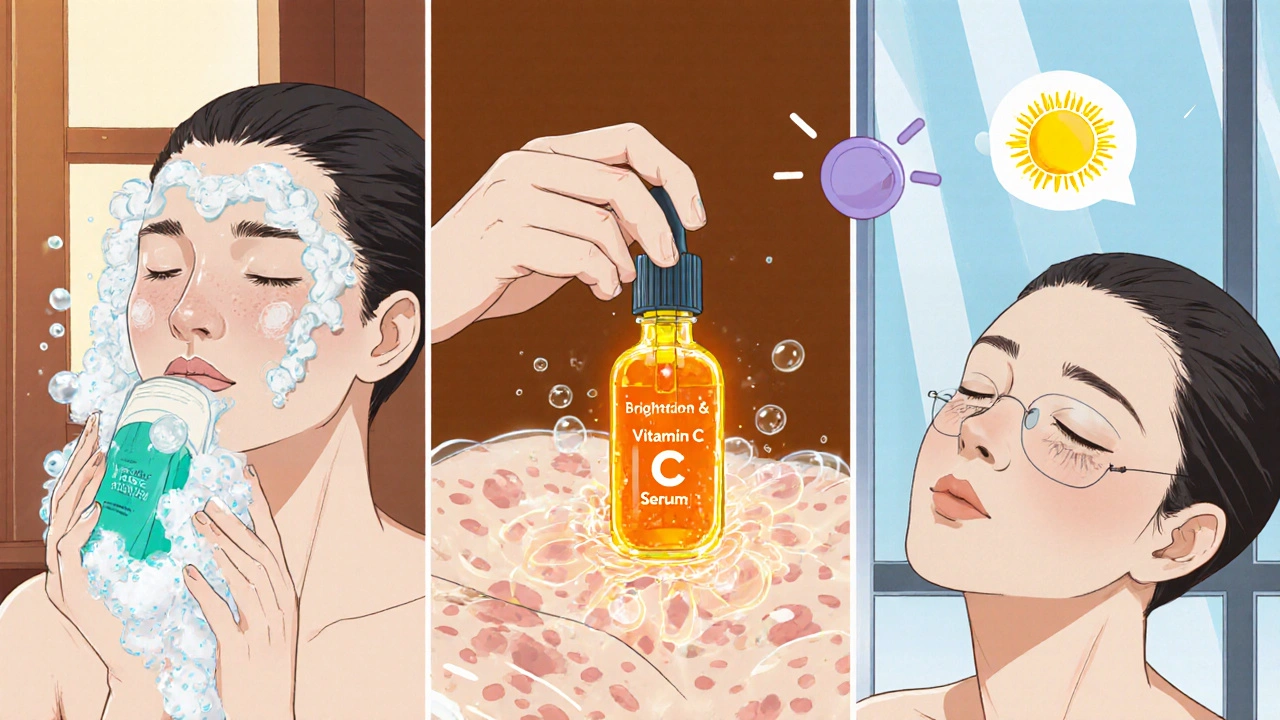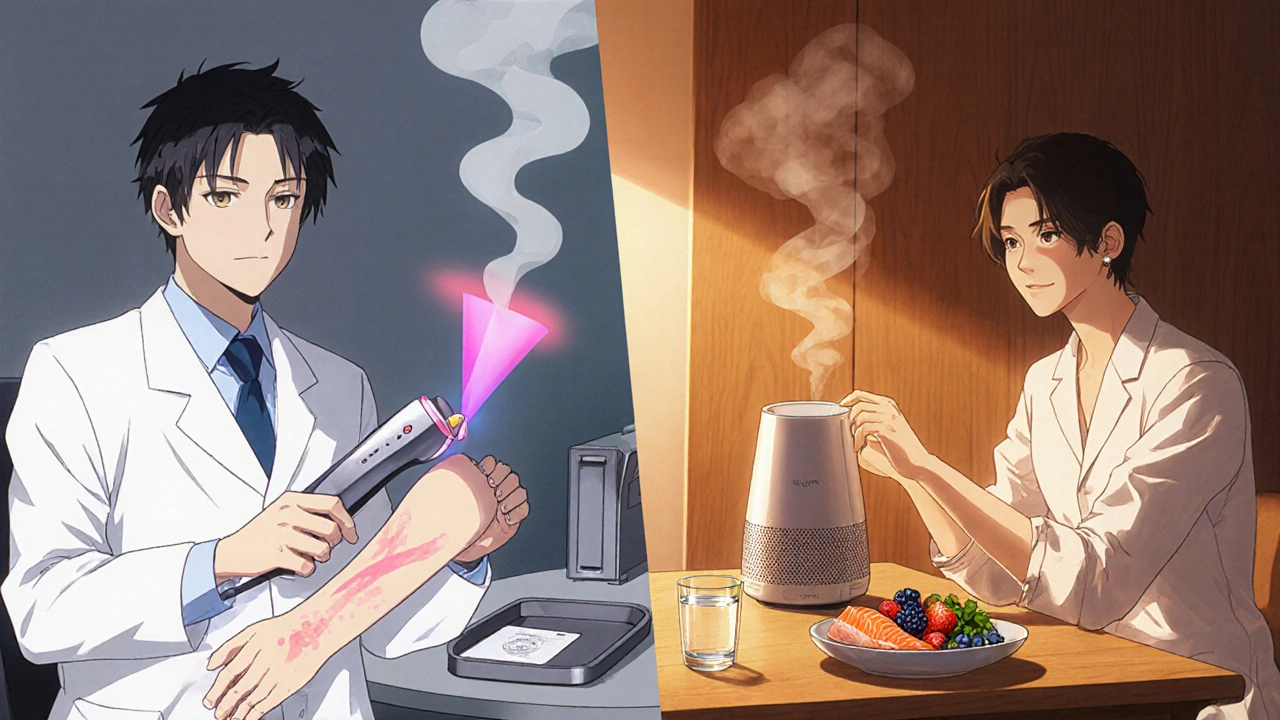Winter Skin Treatment Timeline Calculator
Choose Your Treatment
Select the treatment you're considering for mottled skin discoloration. This calculator estimates when you might see visible results based on winter conditions.
2-4% (OTC)
10-20%
0.3-0.5% (retinol)
Results
Select a treatment option to see expected results timeline.
Winter conditions may extend results timeline by up to 2 weeks due to dry air and reduced skin barrier function.
When the temperature drops and the air gets dry, many people notice their complexion looking uneven, with patches that appear darker or lighter than the surrounding skin. This is mottled skin discoloration is a condition where irregular patches of pigmentation appear on the face or body, often ranging from brown to pinkish tones. While it can affect anyone, winter tends to amplify the problem.
Understanding Mottled Skin Discoloration
At its core, mottled skin discoloration is a form of Hyperpigmentation an excess of melanin production that leads to darker patches on the skin. The underlying causes are varied-sun exposure, hormonal shifts, inflammation, or even genetics can trigger melanin clusters to form. When the skin barrier is compromised, these pigment cells become more visible.
Why Winter Makes It Worse
Cold weather brings three main culprits that aggravate discoloration:
- Low humidity strips moisture from the outermost layer, weakening the barrier and allowing pigment to show through.
- Indoor heating creates a dry micro‑climate that intensifies flakiness and makes dark spots look harsher.
- Reduced sunlight might sound like a good thing, but many people skip their daily Sunscreen a protective product that shields skin from UV radiation, a major trigger for hyperpigmentation in winter, assuming they’re safe indoors.
The combination of a weakened barrier and unprotected UV exposure creates a perfect storm for mottled patches to become more pronounced.
Daily Skincare Routine for Winter
A solid routine is the foundation of any skin‑brightening plan. Below is a step‑by‑step guide that tackles the four pillars: cleanse, hydrate, treat, and protect.
- Cleanse gently: Use a sulfate‑free, hydrating cleanser that won’t strip the skin’s natural oils. Look for ingredients like glycerin or ceramides.
- Hydrate immediately: Apply a Moisturizer a cream or lotion that locks in water and reinforces the skin barrier within two minutes of cleansing. Choose formulas with hyaluronic acid, ceramides, and dimethicone for a lasting seal.
- Target pigment: Incorporate a serum that contains Vitamin C a powerful antioxidant that inhibits melanin production and brightens dark spots or niacinamide. Apply a few drops to the affected areas before your moisturizer.
- Exfoliate wisely: 2-3 times a week, use a mild chemical exfoliant such as an Alpha hydroxy acid (AHA) a fruit‑derived acid that loosens dead skin cells and promotes turnover (e.g., glycolic or lactic acid). Avoid harsh scrubs that can inflame the skin and worsen discoloration.
- Protect daily: Even on overcast days, apply a broad‑spectrum sunscreen with at least SPF 30. Choose a mineral‑based formula if your skin is sensitive, as it sits on the surface and reduces irritation.
Consistency is key-skipping one step may delay results, but the routine is easy enough to stick with throughout the season.

Targeted Treatments that Work
If the home routine isn’t enough, consider adding one of these proven treatments. The table below compares three popular options.
| Ingredient | How It Works | Typical Strength | Time to See Results | Potential Irritation? |
|---|---|---|---|---|
| Hydroquinone | Inhibits tyrosinase, the enzyme that makes melanin | 2-4 % (over‑the‑counter) | 4‑6 weeks | Yes, if used long‑term |
| Azelaic Acid | Reduces melanin production, anti‑inflammatory | 10-20 % | 6‑8 weeks | Minimal |
| Retinoids (Retinol, Tretinoin) | Speeds cell turnover, fades existing pigment | 0.3-0.5 % (retinol) or 0.025 % (tretinoin) | 8‑12 weeks | Can cause dryness, especially in winter |
Choose a treatment based on your skin’s sensitivity and how quickly you want to see improvement. For most people, starting with a lower‑strength azelaic acid serum is a gentle entry point before moving to stronger options.
Professional Options and When to See a Dermatologist
When over‑the‑counter solutions fall short, professional interventions can make a big difference.
- Chemical peels: A dermatologist applies a higher concentration of AHA or glycolic acid, which removes the top layer of skin, revealing a more even tone.
- Laser therapy: Fractional lasers target pigment‑laden cells without damaging surrounding tissue. This method is fast but can be pricey.
- Micro‑needling: Tiny needles create micro‑channels that stimulate collagen and help topical agents penetrate deeper.
Schedule a consultation if you notice any of the following:
- Discoloration that spreads rapidly or changes shape.
- Accompanying symptoms such as itching, burning, or swelling.
- Little or no improvement after six weeks of consistent home care.
A qualified Dermatologist a medical doctor specializing in skin conditions, who can diagnose and prescribe stronger treatments can tailor a plan that fits your skin type and winter lifestyle.

Lifestyle Adjustments to Keep Skin Even
Skincare products are only half the battle. Your everyday habits also shape how your skin looks.
- Maintain indoor humidity: Aim for 40‑50 % humidity using a humidifier. This reduces transepidermal water loss and keeps pigment less visible.
- Stay hydrated: Drinking at least 1.5 L of water daily helps skin retain moisture from the inside out.
- Eat pigment‑friendly foods: Vitamin C‑rich fruits (oranges, kiwi), vitamin E (almonds, sunflower seeds), and omega‑3 fatty acids (salmon, flaxseed) support a clear complexion.
- Avoid hot showers: Prolonged hot water strips oil, worsening dryness and making dark spots pop.
- Limit alcohol and nicotine: Both constrict blood vessels and can exacerbate hyperpigmentation.
Small tweaks add up; you’ll notice smoother, more even skin without any extra product.
Quick Checklist for Winter Skin Success
- Cleanse with a gentle, hydrating formula.
- Apply a moisturizer full of hyaluronic acid and ceramides.
- Use a Vitamin C or niacinamide serum on mottled areas.
- Exfoliate 2‑3 times/week with an AHA product.
- Never skip sunscreen - even on cloudy days.
- Consider azelaic acid or low‑strength retinoid if discoloration persists.
- Keep indoor humidity at 40‑50 %.
- Stay hydrated and consume antioxidant‑rich foods.
- Schedule a dermatologist visit if no improvement after six weeks.
Frequently Asked Questions
Can I treat mottled skin discoloration without prescription medication?
Yes. Over‑the‑counter options like azelaic acid, vitamin C serums, and gentle AHAs can fade most patches when used consistently. Prescription‑strength hydroquinone is reserved for stubborn cases.
Why is sunscreen still needed in winter?
UVB rays penetrate clouds, and reflected light from snow can double exposure. Sun‑induced melanin production doesn’t stop when the temperature drops.
How often should I exfoliate in the colder months?
Two to three times a week is enough for most skin types. Over‑exfoliating strips the barrier, leading to more visible discoloration.
Is there a risk of worsening pigmentation with retinoids?
Retinoids can cause temporary irritation, which may trigger post‑inflammatory hyperpigmentation in sensitive skin. Start with a low concentration and pair with a rich moisturizer.
When should I consider professional laser treatment?
If at‑home products haven’t lightened the spots after 8‑12 weeks, or if the patches are deep and resistant, laser therapy can offer faster, more uniform results under dermatologist supervision.









Winter can be unforgiving to the skin, especially when the barrier is compromised.
First, hydrate the skin immediately after cleansing to lock in moisture.
Second, choose a gentle, sulfate‑free cleanser that respects the natural lipid layer.
Third, apply a moisturizer rich in hyaluronic acid and ceramides within two minutes of washing.
Fourth, incorporate a Vitamin C or niacinamide serum to target pigment formation.
Fifth, exfoliate with a mild AHA two to three times per week, never more.
Sixth, never neglect sunscreen, even on overcast days, because UV rays penetrate clouds.
Seventh, maintain indoor humidity between forty and fifty percent to prevent transepidermal water loss.
Eighth, drink at least one and a half liters of water daily to support skin hydration from within.
Ninth, protect the skin barrier by avoiding hot showers that strip natural oils.
Tenth, limit alcohol and nicotine consumption, as they can exacerbate hyperpigmentation.
Eleventh, consider a low‑strength azelaic acid serum as a gentle entry point for stubborn spots.
Twelfth, if progress stalls after six weeks, schedule a dermatologist consultation for stronger options.
Thirteenth, remember that consistency beats occasional over‑the‑counter treatment bursts.
Fourteenth, keep a simple routine to avoid overwhelming the skin during the colder months.
Fifteenth, stay patient; visible improvement often takes four to eight weeks of diligent care.
Man, they don’t want you to know that the big sunscreen corporations are secretly pumping chemicals that actually mask the real problem while they sell you ever‑bigger bottles.
They say “apply SPF 30 even in winter,” but the indoor heating they push into our homes dries out our skin so badly that no amount of SPF can save us.
And the “gentle cleanser” they recommend? It’s just a marketing ploy to get us to buy more overpriced products.
Wake up, people, the real battle is against the hidden humidity‑draining agents in our heating systems, not just the sun.
That’s why you’ll still see those dark patches even after you follow every step in the guide.
It is imperative to recognize that hyperpigmentation is not merely a cosmetic inconvenience but a manifestation of barrier dysfunction, which, if left unchecked, may signal deeper dermatological concerns.
Thus, adherence to a regimented protocol, as delineated in the article, is not optional but a duty to one's health.
Furthermore, the selective use of over‑the‑counter agents without professional oversight can precipitate iatrogenic irritation, undermining therapeutic goals.
Consequently, individuals should prioritize evidence‑based interventions and seek dermatological consultation when improvement plateaues after six weeks.
Excellent summary of winter skin care; however, let’s emphasize a few critical points-first, the barrier must be fortified before any actives are introduced; second, sunscreen selection should be mineral‑based for sensitive skin; third, the frequency of AHA exfoliation must be tailored to tolerance, not a one‑size‑fits‑all schedule.
In addition, maintaining indoor humidity at forty‑to‑fifty percent is non‑negotiable, as it directly influences transepidermal water loss.
Finally, any persistent pigmentation beyond eight weeks warrants professional evaluation-don’t gamble with DIY methods alone!
Sticking to a simple routine is the best way to keep winter skin even.
Statistically, the majority of winter hyperpigmentation cases resolve within eight to twelve weeks when a consistent regimen of barrier repair, antioxidant serums, and broad‑spectrum SPF is employed 📊.
Moreover, azelaic acid at ten percent concentration has been shown to reduce melanin synthesis by up to thirty percent in controlled trials 📈.
For patients with heightened sensitivity, a low‑strength retinoid can accelerate cellular turnover, provided it is paired with a ceramide‑rich moisturizer to mitigate dryness 🌿.
Thus, the hierarchy of interventions is clear: barrier reinforcement → antioxidant application → controlled exfoliation → targeted actives → sun protection.